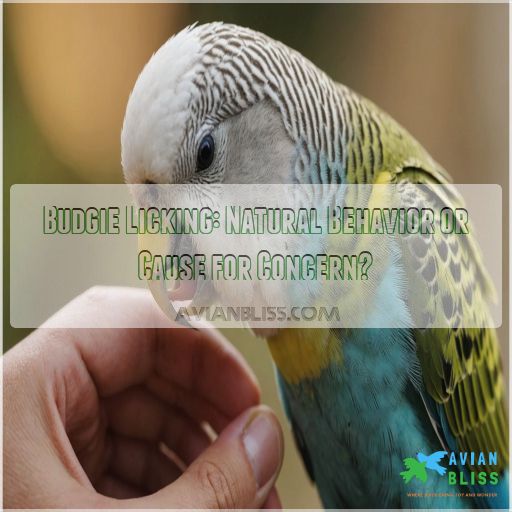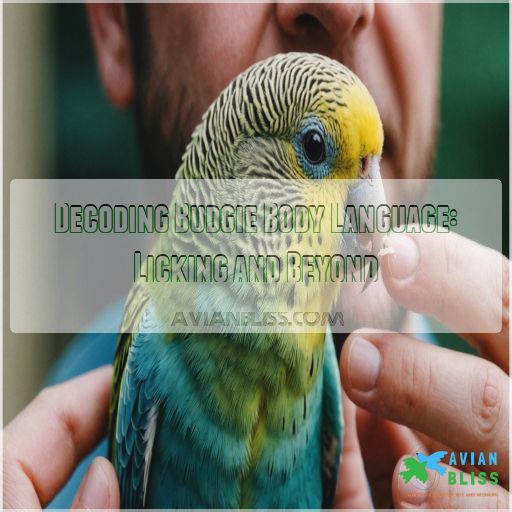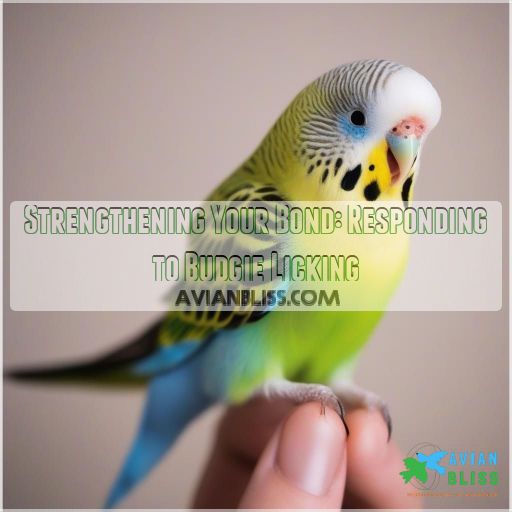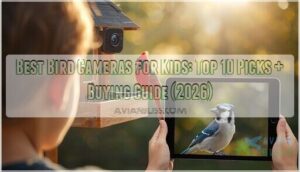This site is supported by our readers. We may earn a commission, at no cost to you, if you purchase through links.
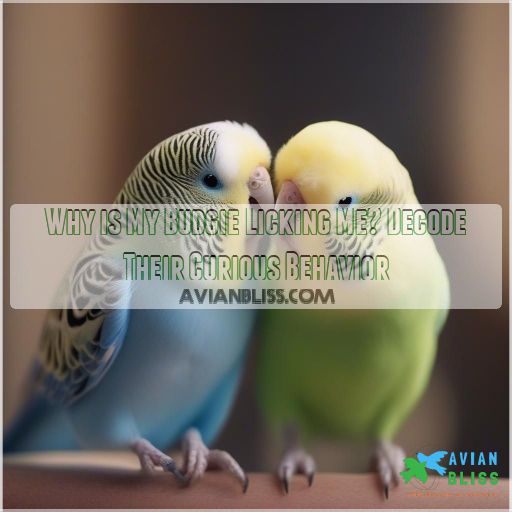 When your budgie starts licking you, don’t worry – it’s not trying to taste-test its next meal! This curious behavior is actually a sign of affection. Your feathered friend sees you as part of its flock and is grooming you, just like it would another budgie. It’s their way of saying, "Hey, you’re one of us!"
When your budgie starts licking you, don’t worry – it’s not trying to taste-test its next meal! This curious behavior is actually a sign of affection. Your feathered friend sees you as part of its flock and is grooming you, just like it would another budgie. It’s their way of saying, "Hey, you’re one of us!"
This licking can also be a form of exploration, as budgies use their beaks and tongues to gather sensory information.
While it’s generally harmless, remember that birds can carry germs, so always wash your hands after playtime. There’s a whole world of budgie body language to decode – and you’ll be surprised at what else your little buddy is trying to tell you!
Table Of Contents
- Key Takeaways
- Budgie Licking: Natural Behavior or Cause for Concern?
- Decoding Budgie Body Language: Licking and Beyond
- Budgie Vocalizations: Understanding Their Communication Methods
- Building Trust: Why Your Budgie Feels Comfortable
- Potential Reasons Behind Excessive Budgie Licking
- 6 Best Products for Happy, Healthy Budgies
- Strengthening Your Bond: Responding to Budgie Licking
- Frequently Asked Questions (FAQs)
- Why does my Budgie not like me?
- Why is my Budgie pecking me so much?
- Why is my Budgie biting me?
- Why is my Budgie aggressive?
- Why does my bird keep licking me?
- Why does my budgie gently bite me?
- How do you tell if your budgie is comfortable with you?
- Why is my budgie grooming me?
- Can budgie licking indicate a nutritional deficiency?
- Why does my budgie lick windows and surfaces?
- How can I discourage my budgie from licking excessively?
- Is budgie licking related to temperature or humidity?
- Should I be concerned about bacteria from budgie licking?
- Conclusion
Key Takeaways
- When your budgie licks you, take it as a feathered high-five! It’s their quirky way of grooming you or gathering information about their environment. It’s like having a curious little detective on your hands.
- Licking might also mean your budgie considers you part of their flock. They’ll preen and cuddle, showing trust and affection. It means you’re now an honorary bird—feathers not included!
- While this behavior is generally harmless, remember birds can carry germs. Wash your hands after playtime, so you don’t end up sneezing more than them!
- If your budgie’s licking seems excessive, it might be a sign they’re seeking attention or snacks. Make sure their diet is top-notch and consider introducing new toys to keep their beak busy.
Budgie Licking: Natural Behavior or Cause for Concern?
When your budgie starts licking you, it’s not time to panic; instead, consider it a quirky form of bonding.
While it may feel strange, this behavior is largely about grooming instincts, social bonding, and curiosity, with a sprinkle of potential health risks to be aware of.
Grooming Instincts in Budgies
When your budgie starts licking you, it’s their instinctual grooming at play.
Just as birds preen feathers, they might see you as part of the flock!
It’s budgie affection in action—trust and care in birdie form, rather like a feathery, miniature pet crossing-guard ensuring you’re well-dusted and polished!
Let’s say you’re truly one of their own.
Social Bonding Through Physical Interaction
Your budgie might lick you as a sign of trust and affection.
It basically says, "You’re part of my flock!"
These gestures can include:
- Grooming and preening.
- Cuddling close.
- Nuzzling your cheek.
- Gentle nibbling.
- Playful pecks.
These bonding behaviors reflect a growing friendship.
Just remember, a little budgie love can tickle, but that’s a small price for companionship!
Exploration and Sensory Information Gathering
Budgies are naturally curious creatures, and their licking behavior is often a way to gather sensory information about their environment and bond with their flock.
They use their sensitive beaks and tongues to explore textures, tastes, and scents, satisfying an innate drive to investigate their surroundings.
Potential Health Risks Associated With Licking
Even if your budgie’s affectionate licks are endearing, they might share germs like Salmonella, E. coli, or Campylobacter .
Plus, dander can trigger allergies.
It’s like walking a tightrope—you love the attention but worry about the sneeze!
To keep things chirpy and healthy, wash hands after handling your budgie to prevent any feathered faux pas.
Decoding Budgie Body Language: Licking and Beyond
When your budgie starts licking you, it’s sharing more than just a taste—it’s speaking its love language.
From gentle cuddles to playful wing flaps, understanding these tiny gestures can turn you into a budgie whisperer and strengthen your friendship.
Cuddling and Nuzzling Behaviors
A budgie cuddling or nuzzling against you isn’t just adorable—it’s a sign of trust and bonding.
When your feathered friend nestles close, they’re saying, “I feel safe.”
It’s like a little birdy hug!
Embrace these affectionate behaviors as signs you’re building a strong relationship, nurturing their comfort, and, dare I say, becoming their favorite human perch .
Wing Flapping and Tail Wagging
Noticed your budgie’s tail wagging? It’s like when friends wave enthusiastically when they see you—tail wagging often means contentment and joy . Then there’s wing flapping, which signals annoyance or a feather out of place.
Here’s how to interpret these lively cues:
- Tail Wagging: Happiness
- Wing Flapping: Annoyance
- Body Language: Key
- Bird Communication: Essential
Pupil Dilation and Eye Contact
The twinkling dance of a budgie’s pupils often holds mysteries waiting to be unraveled!
Rapid pupil dilation could signal excitement or curiosity—your feathery companion is tuned in and ready to learn.
Eye contact can be a trust signal, like a gentle nudge saying, "Hey, I’m listening!"
Harness these moments of eye contact communication to strengthen that precious budgie bond .
Relaxed Posture and Upside-down Hanging
While pupil dilation reveals excitement or curiosity, a budgie happily hanging upside down indicates trust and comfort.
Imagine your budgie performing aerial yoga, feeling secure in their own little world!
This playful behavior signifies safety and happiness.
If your feathered friend feels cozy enough to dangle freely, you’re doing a great job making them feel at home .
Budgie Vocalizations: Understanding Their Communication Methods
Your budgie’s vocalizations are a window into their inner world.
From cheerful singing to tongue clicking, each sound reveals their mood and desire to interact.
Understanding these vocal cues can help you build an even stronger bond with your feathered friend.
Singing and Whistling as Positive Indicators
In the symphony of bird language, your budgie’s singing and whistling are tunes of happiness.
These joyful vocalizations are positive signals that he’s feeling content and cheerful.
Communicating joy, your feathered friend might be:
- Chirping along to music
- Imitating sounds around him
- Engaging with you melodically
- Singing to reassure flock safety
- Whistling in anticipation of treats
Beak Chattering and Tongue Clicking
After enjoying your budgie’s cheerful singing, you might hear beak chattering or tongue clicking.
Don’t fret! These sounds often express curiosity and friendliness.
Imagine it as the bird version of chatting with a new friend.
Beak clicking can signal a bit of unease, though, similar to how we might politely decline unwelcome attention .
Low Growling and Aggressive Sounds
From beak chattering, we switch gears to growls—a budgie’s way of expressing irritation. It’s like your feathery friend saying, “Back off, pal!” Here’s why they might growl:
- Budgie aggression: natural territorial response.
- Causes of growling: Feeling threatened.
- Fearful budgies: Anxiety triggers growls.
- Stress and biting: Growling may precede bites.
Beak Grinding and Contentment Noises
While growling can make you consider a budgie’s grumpiness, beak grinding indicates sheer contentment.
It’s like your budgie’s way of saying they’re happily drifting into dreamland.
Those quiet noises signal a relaxed state, much like a cat’s purr.
If your feathered friend grinds their beak at bedtime, it’s a sure sign of a happy budgie, not stress .
Building Trust: Why Your Budgie Feels Comfortable
Building trust with your budgie involves creating a safe and enriching environment, where your feathered friend feels at home.
Consistent positive interactions and respecting their personal space can lead to a comforting bond; after all, even budgies need their "me time" before showering you with affection.
Creating a Safe and Enriching Environment
Just as understanding budgie vocalizations provides insights, creating a safe, enriching environment is the key to building trust.
Offer a spacious cage.
Make sure:
- Toy variety for stimulation
- Nest placement for comfort
- Food variety to excite taste buds
- Safe materials for health
- Cozy ambiance
These will make your budgie chirp with joy and comfort .
Consistent Positive Interactions and Handling
Consistent positive interactions and handling are key to building trust with your budgie.
Sit near their cage and talk or read aloud to get them used to your presence.
Offer tasty millet treats by hand, moving slowly and letting them approach at their own pace.
Over time, they’ll learn to see you as a friend, not a threat.
Respecting Boundaries and Personal Space
Embrace positive interactions by also honoring your budgie’s personal space to earn their trust.
If your feathered friend flutters away, it’s best to back off and try again later.
Remember, budgies bite if boundaries are crossed .
Think of their space like a tiny invisible bubble—respect it, and you’ll have a happier, trusting budgie.
Offering Treats and Rewards Appropriately
After respecting your budgie’s space, offering treats is a sweet way to bond.
Think of it like this: You wouldn’t shower someone in gifts randomly, right?
Reward good behavior with these:
- Treat Types: Millet sprays, fresh fruits.
- Reward Timing: Immediate praise.
- Overfeeding Risks: Balance moderation.
- Treat Alternatives: Toys or gentle scritches.
Positive reinforcement keeps them chirping with joy!
Potential Reasons Behind Excessive Budgie Licking
If your budgie seems to be licking you excessively, it could be craving attention or stressed out by its environment.
Sometimes, your feathered friend might just be hungry for something more nutritious—so let’s rule out any health hiccups first!
Attention-seeking Behavior
When your budgie licks you, it might just be their quirky way of seeking attention.
Like a little feathered comedian, they’re performing for a laugh or a loving response.
They crave your company and enjoy social interaction.
Distract them with budgie toys or use positive reinforcement during vocalizations, gently guiding their focus to more positive play.
Stress or Anxiety Manifestations
Your budgie’s licking might sometimes be a sign of stress or anxiety.
An anxious budgie might show:
- Feather Plucking: Excessive grooming can indicate distress.
- Overgrooming: Budgies may nibble on you as a soothing mechanism.
- Aggression: Stress can lead to unexpected nips.
- Sleep Changes: Difficulty settling down.
- Behavioral Shifts: Noticeable difference in activity levels.
Humorously enough, your budgie might just be saying, "Help, human!" .
Nutritional Deficiencies or Dietary Issues
Is your budgie’s licking behavior giving you pause? It might be a cry for help!
A diet low in key vitamins and minerals, like calcium, can lead to nutritional deficiencies.
Offering a balanced diet with high-quality pellets, fresh greens, and a pinch of supplements could be the magic trick for a healthier, happier budgie (Source).
Medical Conditions Requiring Veterinary Attention
If your budgie’s excessive licking is accompanied by concerning symptoms like feather plucking, beak problems, respiratory issues, weight loss, or eye discharge, it’s time to schedule a vet visit.
These could signal an underlying medical condition requiring professional attention.
Don’t wait – your feathered friend’s health and wellbeing depend on it.
6 Best Products for Happy, Healthy Budgies
Keeping your budgie happy and healthy involves more than just providing fresh water and food—there’s a world of fun and practical products out there.
Grab a tip-proof bowl for less mess or invest in a maze playset that’ll make your budgie feel like an adventurer without needing a tiny Indiana Jones hat!
1. No Drip Water Bottle for Small Pets
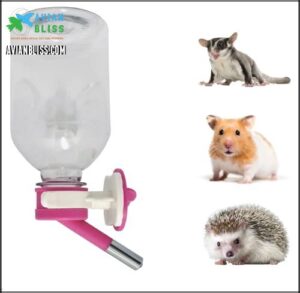
Keeping your budgie hydrated is really important, and the Choco Nose No-Drip Water Bottle is a game-changer.
This nifty gadget prevents leaks, ensuring a dry and comfortable living space for your feathered friend .
With its 10.2 oz capacity and 10mm nozzle, it’s perfect for small pets like budgies.
The leak-proof design means no more wet messes to clean up.
Easy to install and refill, it’s compatible with most regular PET bottles.
Remember to check it daily, though, as some users have reported occasional issues with water flow .
Best For: The Choco Nose No-Drip Water Bottle is best for small pets like budgies, hamsters, hedgehogs, sugar gliders, rats, and mice.
- Prevents water leaks, keeping your pet’s living space dry.
- Easy to install, clean, and refill.
- Compatible with most regular PET bottles.
- The water bottle may be too small for some pets, especially if they have multiple pets in a cage.
- The clip that holds the bottle to the cage can be easily broken.
- Some users have reported occasional issues with water flow.
2. Tip Proof Guinea Pig Bowl
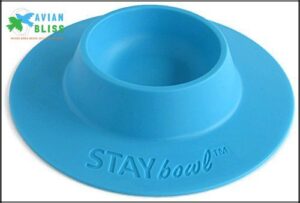
You’ve probably seen your guinea pig flip their food bowl, sending pellets flying everywhere.
It’s frustrating, but don’t worry – there’s a solution!
The STAYbowl is designed to outsmart even the most determined tippers.
With its clever lip and wide base, it keeps food where it belongs – in the bowl.
Made from tough, BPA-free plastic, it’s built to last and easy to clean .
While some piggies might still try their tipping tricks, this bowl makes it much harder .
Just remember, a one-cup capacity might be a bit snug for two hungry furballs!
Best For: The STAYbowl is best for guinea pig owners who are frustrated with their piggies constantly flipping over their food bowls.
- Keeps food clean and off the floor
- Saves time and money
- Promotes health and wellness
- One cup capacity might be a bit small for two guinea pigs
- Takes up a fair amount of space in the cage
- Food can get stuck in the small crevices of the bowl, making it difficult to clean
3. Small Animal Cage Cleaning Set

If you’re looking to keep your little friend’s home spick and span, a reliable cage cleaning set can make all the difference.
Look for a kit with firm brush bristles and a flexible dust pan lip to tackle those tricky corners .
While some users find the bristles too stiff, many praise how these tools speed up the cleaning process (Source).
Just remember, your budgie’s sensitive respiratory system means you should avoid scented products.
Opt for a non-toxic, fragrance-free cleaner that’s safe for small animals and eliminates odors without harsh chemicals.
Best For: This cleaning set is ideal for owners of hamsters, chinchillas, squirrels, guinea pigs, rabbits, ferrets, hedgehogs, reptiles, and other small caged pets.
- Easy to use and clean.
- Makes cage cleaning faster and easier.
- Perfect size for small cages.
- Bristles are too stiff for some users.
- Dust pan is smaller than expected and made of flimsy plastic.
- Some users found the product overpriced.
4. Hamster House Maze Playset
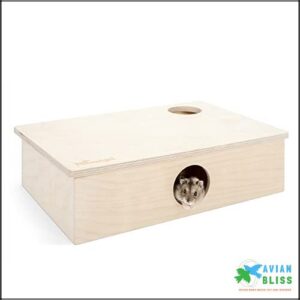
After a long day of hamster antics, your furry friend deserves a cozy retreat.
The Hamster House Maze Playset offers just that, with six rooms and two entrances for endless exploration .
Made from high-quality birch plywood, it’s a sturdy and safe option for your little adventurer.
While it’s designed for dwarf hamsters, you’ll want to think about the size of your cage before bringing this 12.8 x 8.5 x 3.3-inch mansion home.
Don’t forget to smooth any rough edges with the included sandpaper – your hamster’s comfort is key!
Best For: The Hamster House Maze Playset is best for dwarf hamsters who enjoy exploring and have a spacious cage.
- Made from high-quality birch plywood for durability.
- Features six rooms and two entrances for ample exploration.
- Comes with sandpaper to smooth any rough edges for your hamster’s comfort.
- Wood can absorb urine odors.
- Large size may not fit in smaller cages.
- Some users have reported needing to glue parts together.
5. Hamster Chew Toys Wooden Pine 12 Pack

These 12 wooden chew toys are a birdkeeper’s dream come true.
Your feathered friend will be over the moon with the variety of shapes, from watermelon balls to bell swings.
Crafted from high-quality, sun-dried wood, they’re as safe as they’re fun.
The non-toxic, MSDS-approved materials will keep your budgie’s beak in tip-top shape.
While marketed for various small pets, they’re perfect for your avian companion.
Just keep an eye on the sizing – some pieces might be better suited for smaller birds.
With this pack, your budgie’s playtime will be anything but boring!
Best For: These chew toys are best for bird owners looking for a variety of safe and fun options to keep their feathered friend entertained.
- Variety of shapes: Provides plenty of options for chewing and playing .
- Safe and durable: Made from high-quality, sun-dried wood and non-toxic materials .
- Encourages beak health: Helps with teeth growth and keeps beaks in tip-top shape .
- Sizing may not be ideal for larger birds: Some pieces might be better suited for smaller birds .
- Potential for damage: Product can arrive damaged .
- Some toys may be unstable: The teeter-totter may be unstable .
6. Silent Hamster Exercise Wheel
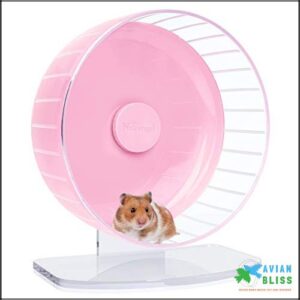
For your hamster’s health and happiness, consider the Niteangel Silent Hamster Exercise Wheel. This sturdy plastic wheel boasts dual ball bearings for whisper-quiet operation .
You’ll love its adjustable height (1-5.5 inches) and easy-to-clean design. While it’s pricier than some options, the quality speaks for itself.
Users rave about its durability and chew-resistant properties . Just make sure your cage has enough room for this 11-inch beauty!
A small caveat: some owners report a slight hum after cleaning, but it’s still one of the quietest wheels around .
Best For: The Niteangel Silent Hamster Exercise Wheel is best for hamster owners who prioritize a quiet and durable wheel for their furry friends.
- Whisper-quiet operation: Dual ball bearings ensure a smooth and silent spin, even when your hamster is running at night .
- Adjustable height: You can easily customize the wheel’s height to fit your cage and your hamster’s size .
- Durable and chew-resistant: Made from sturdy plastic, it can withstand even the most enthusiastic chewers .
- Pricey: The Niteangel wheel is more expensive than some other options .
- Potential for humming: Some users have reported a slight hum after cleaning .
- Large size: Ensure your cage has enough room to accommodate the 11-inch wheel .
Strengthening Your Bond: Responding to Budgie Licking
You’ve decoded your budgie’s licking behavior, but now it’s time to take your bond to the next level.
Let’s explore how to respond positively to this affectionate gesture while setting healthy boundaries and introducing new ways to strengthen your connection with your feathered friend.
Positive Reinforcement Techniques
While your budgie’s licking might seem odd, it’s a golden opportunity to strengthen your bond through positive reinforcement.
Think of yourself as a bird whisperer, using these techniques to communicate:
- Clicker training for desired behaviors
- Offering small treat rewards
- Using consistent praise words
- Incorporating gentle, positive touch
Remember, you’re not just training your feathered friend – you’re building a language of trust and affection.
Who knew a little birdie could be such a great conversationalist?
Establishing Clear Boundaries and Routines
Once you’ve built trust with your budgie, it’s time to lay down some ground rules.
Set clear boundaries by consistently returning your feathered friend to their play stand if they venture out of bounds .
Establish a routine for "step up" commands, treat time, and cage time.
Remember, consistency is key – just like training any pet, your budgie will thrive on predictable patterns and gentle guidance.
Introducing Alternative Bonding Activities
Now that you’ve set clear boundaries, let’s spice up your budgie bonding!
Interactive toys are your new best friend.
Set up a playtime routine that’ll have your feathered pal chirping with joy.
Try foraging enrichment – it’s like a treasure hunt for treats!
Training exercises can turn your budgie into a little Einstein.
And who says you can’t share a meal?
Just make sure it’s bird-friendly fare.
These activities will strengthen your bond without encouraging excessive licking .
Recognizing Signs of Discomfort or Overstimulation
Four key signs can help you spot when your budgie’s had enough. Watch for:
- Feather plucking or ruffling
- Rapid wing flapping
- Abrupt head shaking
- Sudden pupil dilation (pinning)
These behaviors are your feathered friend’s way of saying, "Time out, please!"
If you notice these signs, it’s best to give your budgie some space.
Remember, even the chattiest parrots need their alone time . Don’t take it personally – you’re still their favorite human!
Frequently Asked Questions (FAQs)
Why does my Budgie not like me?
Like a skittish butterfly, your budgie’s trust is delicate.
You’ve likely startled it or changed your routine .
Spend time talking softly, offer treats, and be patient.
Your feathered friend’s affection will slowly bloom again with consistent care.
Why is my Budgie pecking me so much?
Your budgie’s pecking could be a sign of bonding or preening behavior .
It might also indicate curiosity or excitement.
If the pecking feels aggressive, your budgie might be trying to establish dominance or express frustration .
Why is my Budgie biting me?
Budgies might bite due to fear, territorial instincts, or hormonal changes during mating season .
They could also be playing or seeking attention .
To curb this behavior, respond calmly and consistently, avoiding reinforcement of biting through unintended rewards .
Why is my Budgie aggressive?
Budgie aggression can stem from hormonal changes, territorial behavior, or stress.
Removing mirrors and rearranging the cage may help.
If aggression persists, consider consulting an avian vet to rule out health issues .
Why does my bird keep licking me?
Birds often lick you out of curiosity or attachment, sensing salty skin as irresistible .
It’s akin to toddlers’ tactile adventure through taste.
Marvel at their charming curiosity while ensuring cleanliness to protect their fragile feathered health .
Why does my budgie gently bite me?
Your budgie’s gentle nibbling is their way of exploring and bonding, like a toddler testing the world with their mouth.
It craves interaction and attention, so redirect this curiosity with toys and gentle handling .
How do you tell if your budgie is comfortable with you?
Like a loyal dog wagging its tail, a comfy budgie will sing, preen, and even nap in your presence.
They might nibble gently or express excitement with playful antics, showing they trust and enjoy your company .
Why is my budgie grooming me?
Your budgie is grooming you as a sign of affection and trust.
It’s their way of bonding with you and showing they feel comfortable in your presence.
Just be cautious around the eyes to avoid any accidental injuries.
Can budgie licking indicate a nutritional deficiency?
A budgie licking behavior might signal nutritional deficiencies, like a lack of certain minerals or vitamins, but it could just be curiosity or habit.
Always consult a vet to rule out nutritional issues .
Why does my budgie lick windows and surfaces?
Imagine your budgie as a tiny detective, exploring shiny surfaces.
It might think its reflection is another budgie or seek minerals.
Make sure there’s no harmful licking and consider a vet visit if it persists .
How can I discourage my budgie from licking excessively?
Try offering your budgie new toys and mineral blocks to redirect its licking behavior.
It could be seeking minerals or just be bored, so a vet visit might help rule out deficiencies .
Is budgie licking related to temperature or humidity?
Picture a curious little budgie using its tongue like a detective.
Licking isn’t directly linked to temperature or humidity but is more about exploring textures and building a bond with you, akin to a feathered friend handshake .
Should I be concerned about bacteria from budgie licking?
No need to panic about your budgie’s licks; just wash your hands afterward to avoid bacterial risks like salmonella or psittacosis.
It’s all about keeping things clean and not letting them kiss you (Source).
Conclusion
Ultimately, your budgie’s licking behavior is a heartwarming display of affection and trust.
By decoding their "feathery" body language, you’ll forge an even stronger bond with your beloved "why is my budgie licking me" companion.
Remember to provide a nurturing environment, respect their boundaries, and enjoy the unique ways they communicate their fondness.
With patience and understanding, you’ll understand the full depth of your budgie’s endearing personality.

